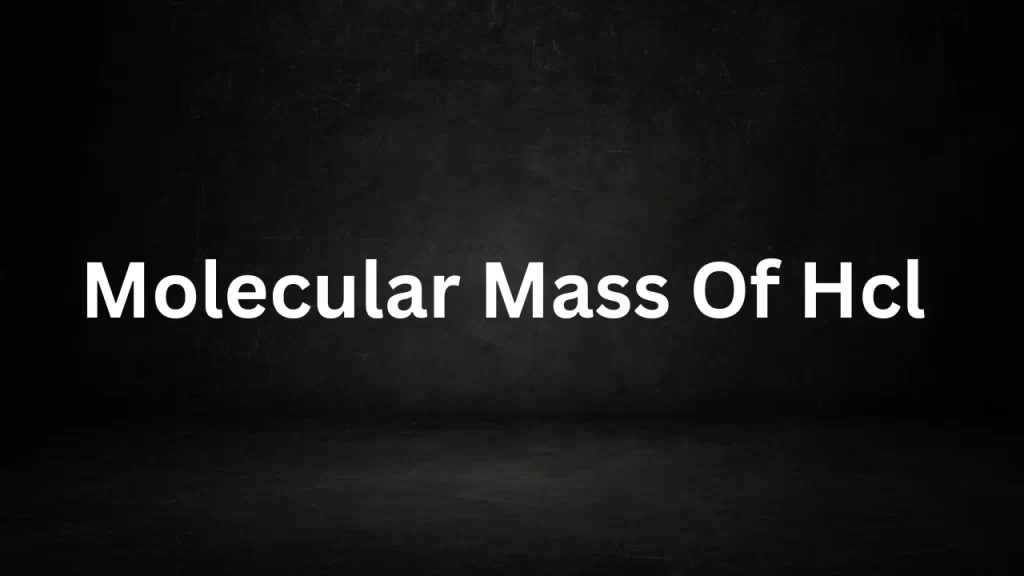Tag: molecular weight of concentrated hcl
Molecular Mass of HCl
Molecular Mass Of Hcl: Hydrochloric acid, represented by its chemical formula HCl, is a ubiquitous and crucial chemical compound with numerous applications in various industries, laboratory settings, and even within the human body.
To understand its properties and behaviors, one fundamental aspect to explore is its molecular mass. In this article, we delve into the molecular mass of HCl, elucidating its significance, calculation, and practical implications.
Molecular Mass Of Hcl
Molecular Mass: A Primer
Molecular mass, often referred to as molecular weight or molar mass, is a fundamental concept in chemistry. It denotes the mass of one mole of a chemical compound and is expressed in atomic mass units (amu) or grams per mole (g/mol). The molecular mass of a compound is a sum of the atomic masses of all the atoms present in its chemical formula.
Components of HCl: Hydrogen and Chlorine
Hydrochloric acid (HCl) is a diatomic molecule composed of two different elements: hydrogen (H) and chlorine (Cl). To determine the molecular mass of HCl, we must consider the atomic masses of these constituent elements:
- The atomic mass of hydrogen (H) is approximately 1.008 amu (atomic mass units).
- The atomic mass of chlorine (Cl) is approximately 35.453 amu.
Calculation of the Molecular Mass of HCl
The molecular mass of HCl is calculated by simply adding the atomic masses of its constituent atoms:
Molecular Mass of HCl = Atomic Mass of H + Atomic Mass of Cl Molecular Mass of HCl = 1.008 amu + 35.453 amu
Molecular Mass of HCl ≈ 36.461 amu
Significance of HCl’s Molecular Mass
Understanding the molecular mass of HCl holds substantial importance due to its wide-ranging applications:
- Chemical Analysis: In analytical chemistry, the molecular mass of HCl plays a vital role in titrations and quantitative analysis. Chemists use it as a reference point to calculate the amount of HCl needed for specific reactions.
- Industrial Processes: Hydrochloric acid is utilized in numerous industrial processes, including chemical manufacturing, metal cleaning, and pH adjustment in water treatment. Knowledge of its molecular mass aids in accurate dosing and control.
- Laboratory Research: Researchers in various scientific disciplines use HCl in laboratory experiments and synthesis. Knowing its molecular mass allows for precise measurements and calculations in experimental setups.
- Biological Functions: In biology, the molecular mass of HCl is relevant in the digestive system. Gastric acid in the stomach, which contains HCl, assists in the breakdown of food. Understanding the concentration of HCl is essential for understanding digestive processes.
- Practical Implications: The mol mass of HCl, approximately 36.461 amu, represents the mass of one mole of HCl molecules. In practical terms, this means that one mole of HCl molecules weighs approximately 36.461 grams. This knowledge is essential for various chemical calculations, including determining the concentration of HCl solutions and predicting the amount of HCl required for specific reactions.
Conclusion
The mol mass of HCl is a fundamental property that defines the mass of this important chemical compound. With a mol mass of approximately 36.461 amu, HCl finds applications in chemistry, industry, and biology, impacting a wide range of fields and processes. Understanding HCl’s mol mass is a cornerstone of accurate chemical analysis, experimentation, and industrial applications, underscoring its significance in the world of science and technology.
Read More
- Molecular Weight Of Carbon
- Molecular Weight Of Hydrogen
- Molecular Weight Of Urea
- Molecular Mass Of Urea
Frequently Asked Questions (FAQs) Molecular Mass Of Hcl
1. What is the mol mass of hydrochloric acid (HCl)?
The mol mass of hydrochloric acid (HCl) is approximately 36.461 atomic mass units (amu) or grams per mole (g/mol). This value represents the total mass of one mole of HCl molecules, taking into account the atomic masses of hydrogen (H) and chlorine (Cl) in the compound.
2. How is the molecular mass of HCl calculated?
The mol mass of HCl is calculated by adding the atomic masses of its constituent elements, hydrogen (H) and chlorine (Cl):
mol Mass of HCl = Atomic Mass of H + Atomic Mass of Cl mol Mass of HCl = 1.008 amu (H) + 35.453 amu (Cl) mol Mass of HCl ≈ 36.461 amu
3. Why is the mol mass of HCl important in chemistry?
The mol mass of HCl is essential for various chemical calculations and stoichiometry. It is used to determine the quantity of HCl required for specific reactions, the concentration of HCl solutions, and to predict the outcome of chemical reactions involving HCl.
4. How does the mol mass of HCl compare to other common compounds?
The mol mass of HCl, approximately 36.461 amu, is relatively low compared to many other compounds. For example, water (H₂O) has a mol mass of approximately 18.015 amu, making HCl significantly heavier than water on a per-mole basis.
5. What are the practical applications of knowing the molecular mass of HCl?
Knowledge of the mol mass of HCl is important in various fields:
- Chemical Analysis: It is used to determine the concentration of HCl in solutions during titration experiments.
- Industrial Processes: In industrial settings, it helps in accurately dosing HCl for chemical manufacturing and treatment processes.
- Laboratory Research: Researchers use it in experimental setups to calculate reactant quantities and measure reaction progress.
- Biological Functions: In biology and medicine, it’s relevant in understanding the role of stomach acid, which contains HCl, in digestion.
